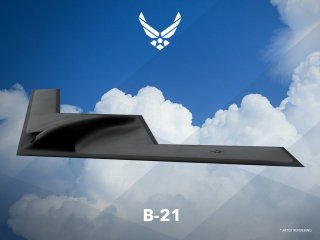A Chinese Company Claims Its UAV Rivals America’s Upcoming B-21 Raider
Feilong-2 appears to be an impressive machine in its own right, but it is not the B-21 killer that it’s being marketed as.
Here’s What You Need to Remember: The Feilong-2 is among the latest fruits of China’s aggressive investment into unmanned stealth flying-wing technology; still, scaling these designs to offer the same level of performance as next-generation manned bombers has proven to be an immensely complex task.
A Chinese drone company claims to have manufactured an unmanned aerial vehicle (UAV) prototype that could rival, if not exceed, the U.S. Air Force’s upcoming B-21 Raider heavy bomber.
Chinese firm Zhongtian Feilong Intelligent Technology recently announced on its WeChat social media account it completed a prototype of its Feilong-2 combat drone prototype, according to a report by the South China Morning Post.
As explained by Zhongtian Feilong, the Feilong-2 is a multirole, subsonic flying-wing UAV intended for precision strikes against high-value assets and infrastructure. The drone boasts a payload capacity of six tons, a cruise speed of 600 kilometers per hour (km/h) and a top flight speed of 780 km/h, flight altitude of 49,000 feet, and an operating range of around 7,000 kilometers. The Feilong-2, or “Flying Dragon-2,” can support drone swarm tactics, both for reconnaissance/surveillance and saturation strike purposes. Designed with a bevy of stealth penetration features, this new drone is the latest addition to China’s emerging anti-access/area denial ( A2/AD) strategy to threaten and contain U.S. assets operating in the Pacific region. It is currently unknown when the Feilong-2, one of several ongoing Chinese combat drone projects, will enter serial production.
According to Zhongtian Feilong, the Feilong-2 comes close in performance to U.S. Air Force’s next-generation B-21 Raider. “This means the American B-21 has already fallen behind, even before it enters service,” the company added.
It is not immediately clear what information Zhongtian Feilong is basing this optimistic assessment on, as the B-21 Raider’s performance specifications have not yet been publicly revealed. As it stands, it is not even clear that the Feilong-2 can consistently perform on the level of the older B-2 Spirit, let alone its more advanced B-21 successor. Based on what is currently known about the Feilong-2, it appears that the B-2 Spirit is faster at a maximum speed of 1,010 km/h and cruise speed of 900 km/h and boasts a substantially greater payload capacity of twenty tons. The two aircraft are virtually tied in range and in maximum flight altitude. Given the clear performance gap that already exists between the Feilong-2 and older U.S. bombers, it is all but guaranteed that this new Chinese drone will fare even worse against the upcoming B-21 Raider.
Zhongtian Feilong’s other claims are easier to digest. The Feilong-2 may very well be cheaper than the B-21 Raider’s price tag of roughly $550 million per unit, and it may very well have a longer operating lifespan. As a drone, the Feilong-2 also offers another key advantage over its manned counterparts: it can execute high-risk operations deep in enemy airspace without endangering the lives of military personnel.
The Feilong-2 is among the latest fruits of China’s aggressive investment into unmanned stealth flying-wing technology; still, scaling these designs to offer the same level of performance as next-generation manned bombers has proven to be an immensely complex task. Feilong-2 appears to be an impressive machine in its own right, but it is not the B-21 killer that it’s being marketed as. Rather, China’s answer to the B-21 Raider will come in the form of its own, manned next-generation Xian H-20 stealth bomber.
Mark Episkopos is a national security reporter for The National Interest.
This article is being republished due to reader interest.
Image: Reuters.

